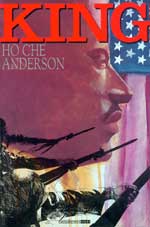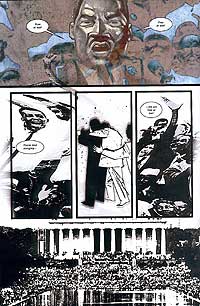 "King" volume one
"King" volume one |
Still available, "King" volume one establishes the series' tone — an attempt to get beyond the near-saintly mythologization of King's life. Focusing primarily on his early adulthood as a charismatic theology student and young minister, volume one includes such unexpected moments as when King explodes at his wife Coretta over her complaints about having no life of her own. "Did I tell you to have that baby?" he screams. A few pages later he invites an attractive New York acolyte up to his hotel room. But such salacious details take a backseat to the more important business of the civil rights struggle. Volume one peaks with the Montgomery bus boycott and ends as King gets stabbed during a lunch-counter protest.
 "King" volume two
"King" volume two |
Part two puts you right in the middle of all the most important civil rights actions from 1960 to 1965, culminating in the March on Washington. Anderson deftly moves from the terrifying street-level violence, such as the brutal Birmingham marches, into the backrooms where squabbling amongst competing organizations continually challenged the success of all their efforts. Several fascinating sequences imagine, with reasonable guesswork, the private conversations between JFK and MLK. Where more scholarly biographies could give us little of such moments, Anderson's novelistic approach allows us to feel the chemistry between these two indomitable, yet morally nuanced, characters. As the book goes on the artistic advantages of this approach become more clear. "King" goes beyond history to examine life's complications, particularly pertaining to racial relations. King the character becomes the personification of these complications.
But of course what really separates "King" from other biographies is that Anderson literally drew it out. For the most part the book has been rendered in very high-contrast black and white — a fascinating choice given the subject. When not cast in nearly complete shadow, characters look as though brightly lit from one direction, horror-movie style. Features get flattened, and more importantly, skin tone vanishes. For better or worse this makes it difficult to distinguish between characters, black or white. Arguably this lack of shading also counters the book's themes of moral shading. But then, just discussing the graphics for their rhetorical meaning puts this book in special league all its own.
 The "I Have a Dream" speech, from Ho Che Anderson's "King" volume two
The "I Have a Dream" speech, from Ho Che Anderson's "King" volume two |
When the word "cinematic" gets applied to comix it usually comes from lazy, patronizing critics caught off guard by the medium's full artistry. But for "King," "cinematic" accurately describes the post-modern, documentary-style construction. For example, Anderson inserts anonymous witnesses who talk directly to the audience, filling in details or offering counter-histories. He also lays in archival photos or documents and draws around them. This approach reaches a climax at the end of "King" II, with a remarkable seven-page montage dedicated to the "I Have a Dream" speech. Photos of the crowd on the Mall, smeared electronically, mixed with historical photos of Klansmen and lynchings bring the book to as much of a visual boil as the words to that famous speech.
Rare and vital, Ho Che Anderson's "King" adds a significant contribution to the depth of artistry and subject matter in the world of graphic literature. Even if read individually "King" volume two works as the complex portrait of a man's rise to power on the basis of immutable moral convictions that even he could not always live up to. Though the ultimate chapter remains to be seen, the "King" series shapes up to contain all the drama and historicity of other great novels.
"King" volumes one and two are available at better comicbook stores and the Fantagraphics' website
